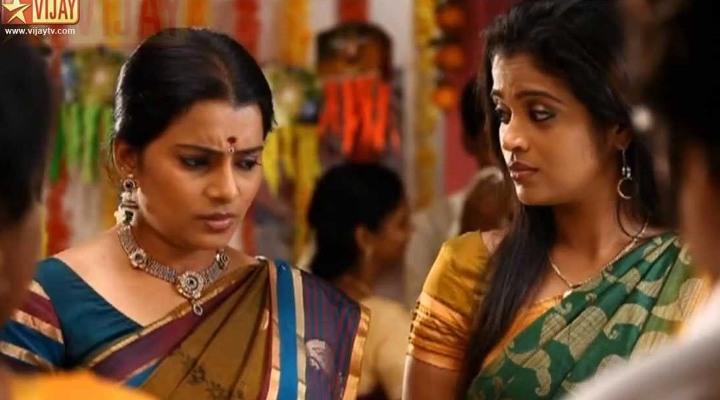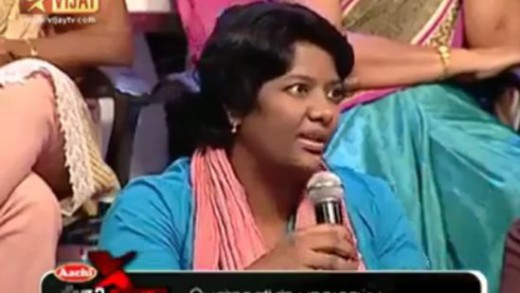Vijay TV is a staple in my house. My mother has it on 24/7, I think she finds the constant stream of images from South India a welcome reprieve from the cold and dreary days we’ve been having lately. For anyone familiar with the channel, you know that serials take up much of the daily programming. So, a major part of my evening consists of watching my mother sucked into the hysterics of on-screen characters that I have come to know, but not quite love.
Indian serials are an unstoppable force in television with their over the top yet addictive dramatics. People gather to soak up the latest offering of conflict on the small screen. And while I think about the implications for women portrayed in stereotypical roles I can’t help but laugh as I watch my mother obsess over what will happen to Saravanan and Meenakshi or if Karthik will put aside his ego for true love in “The Office.”
The disagreement, drama and action is a near perfect mix for a daily dose of entertainment provided by many serials but can we relate to any of the lead or supporting female characters? Let’s also note the giant heteronormative backdrop for these serials where the plot almost always surrounds marriage. Whether it’s about a woman who’s about to get married, dealing with being newly married, has been cheated in marriage, or is trying to find love for eventual marriage- the elusive M word is the end goal! Right?
So who are these characters? What are they telling us about women? And why do we watch them?
Malevolent Mamiyaar
A staple in every serial, the plot just cannot be a plot without Malevolent Mamiyaar or the mother-in-law. This character is seen as an all-powerful matriarch in Indian families, one whose word is literally the last word. It’s an attractive concept for women to hold such power in their homes; however, sadly, the implicit message is not quite positive. The Mamiyaar is often shown to be the villain in the house misusing her power, guided by emotional insecurities and threatened by younger women. While in reality tension in families, especially extended families is normal, it’s hardly the by-product of one sneaky, scheming matriarch. Mother-in-laws are more than often immense supports in families and contribute to managing homes, childcare, and elder care.
Meek Marumagal
Marumagal or daughter-in-law who is usually depicted as the self-sacrificing, burdened, loving and all round Sita-esque character is another staple. Stories revolve around this character loaded with family burdens often created by her mother-in-law. Much like a new pledge in some awful American sorority, she is constantly tested and made to prove her worth. Her many burdens include cooking, cleaning, keeping her husband happy and just generally everyone in the home happy. Oh, and Marumagal also has to maintain herself and ensure she always looks pretty with her Colgate smile- in that Stepford kinda way.
So can we relate? Apart from these characters being largely one-dimensional, they also seem ridiculously removed from reality as they go about their daily business draped in the finest Kanchivaram saris and the equivalent of their weight in gold.
Relationships with family are always complicated. The lesson in these serials, much like the lesson about being a ‘good woman’ that so many of us grew up with, is about always putting others first and by default thinking of ourselves last. I personally struggle with the contrived guilt of my ‘selfish choices’. And by selfish choices, I mean ones that are just good decisions for my life that my family might not like or might disagree with. With this perspective, watching these serials can be infuriating because of the explicit message of a woman’s role or the ideal she should model.
Despite not having any interest myself in these serials, I can understand how they can become a guilty pleasure. Serials can be found across cultures, and all feature overly dramatic storylines that are far removed from reality, but fulfil a need of escapism that is universal. While they may appear to have high entertainment value, once you start looking closer it becomes increasingly clear that what these serials advocate is a world where the status quo is not questioned. This is disheartening in a climate where Tamil films are slowly making steps to tell stories that showcase a diversity of characters. Once where the heroine was simply trotted out for a few songs during the course of a three hour movie, women now play major roles and sometimes even title characters. Even if the effects of these shows may seem miniscule, the fact remains that media is not consumed in a vacuum, instead it informs and is informed by our culture. So while my mother may continue to update me on Meenakshi’s seemingly never ending trials and tribulations and I may even find myself intrigued by the occasional plot twist, it’s important to watch with a critical eye.
-Author: Jaspreet Soor
Related:

 Guest Contributor
Guest Contributor









